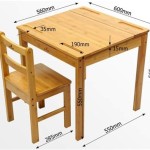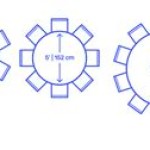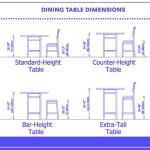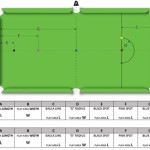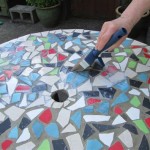Round Dining Tables For 4: A Comprehensive Guide
Round dining tables for four offer a unique blend of functionality and aesthetics, making them a popular choice for smaller dining spaces and intimate gatherings. Their circular design promotes conversation and inclusivity, fostering a sense of connection among diners. This article explores the various aspects of round dining tables designed to comfortably seat four people, covering materials, styles, sizing considerations, and placement strategies.
Key Point 1: Material Variations and Their Implications
The material of a round dining table significantly influences its overall appearance, durability, and maintenance requirements. Common materials include wood, glass, metal, and composite materials, each offering distinct advantages and disadvantages.
Wood: Wooden round dining tables are a classic choice, offering warmth, natural beauty, and versatility. Hardwoods like oak, maple, and walnut are known for their durability and resistance to scratches and dents, making them ideal for everyday use. Softwoods, such as pine and fir, are more affordable but require more careful handling. The finish applied to the wood also plays a crucial role. A protective sealant or varnish can shield the wood from moisture and stains, while a natural oil finish enhances the wood's grain and texture. Wooden tables can be styled to fit a variety of aesthetics, from rustic and traditional to modern and minimalist.
Glass: Glass-topped round dining tables create a sense of spaciousness and lightness, making them particularly suitable for smaller dining areas. The transparency of the glass allows natural light to filter through, brightening the room. Tempered glass is the preferred choice for dining tables due to its strength and safety. If broken, it shatters into small, relatively harmless pieces. Glass tables are easy to clean and maintain, typically requiring only a damp cloth and mild detergent. However, they can be prone to fingerprints and smudges and may require more frequent cleaning. The base of a glass-topped table can be made from various materials, such as metal, wood, or acrylic, allowing for a range of design possibilities.
Metal: Metal round dining tables offer a sleek and modern aesthetic, often associated with industrial and contemporary styles. Steel and aluminum are common choices, providing strength and durability. Metal tables are resistant to heat, water, and stains, making them a practical option for households with children or pets. However, metal can be cold to the touch and may require a tablecloth or placemats for added comfort. Different finishes, such as powder coating, chrome plating, and brushed metal, can alter the table's appearance and texture. The base of a metal table can be intricately designed, adding visual interest to the dining space.
Composite Materials: Composite materials, such as MDF (Medium-Density Fiberboard) and particleboard, are often used in the construction of round dining tables to reduce costs. These materials are typically covered with a veneer or laminate to create a more aesthetically pleasing surface. While composite tables are more affordable, they are generally less durable than solid wood or metal tables. They are also more susceptible to damage from moisture and impact. Laminates and veneers can mimic the appearance of wood, stone, or other materials, offering a wide variety of design options. Proper sealing and edge banding are essential to protect composite materials from moisture and prevent them from swelling or warping.
Key Point 2: Style and Design Considerations
The style and design of a round dining table should complement the overall aesthetic of the dining room or kitchen. Round tables are available in a wide range of styles, from traditional and formal to modern and casual. Factors to consider include the table's shape, base design, finish, and detailing.
Traditional Style: Traditional round dining tables often feature ornate details, such as carved legs, decorative aprons, and rich wood finishes. They are typically made from hardwoods like mahogany, cherry, or walnut and may be adorned with intricate inlays or marquetry. Traditional tables often have a pedestal base or cabriole legs, adding a touch of elegance and sophistication to the dining space. They are best suited for formal dining rooms with classic décor and traditional furnishings.
Modern Style: Modern round dining tables emphasize clean lines, minimalist designs, and a focus on functionality. They often feature simple geometric shapes, such as a circular tabletop and a sleek pedestal base or straight legs. Materials like metal, glass, and lacquered wood are commonly used in modern designs. Color palettes tend to be neutral, with black, white, gray, and natural wood tones predominating. Modern tables are well-suited for contemporary dining rooms and kitchens with a streamlined and uncluttered aesthetic.
Rustic Style: Rustic round dining tables evoke a sense of warmth and naturalness, often featuring distressed finishes, exposed wood grain, and natural materials. They may be made from reclaimed wood, live-edge wood slabs, or rough-hewn timbers. Rustic tables often have a sturdy, farmhouse-style base made from wood or metal. They are best suited for casual dining areas with a rustic or farmhouse-inspired décor. The imperfections and irregularities in the wood add character and charm to the table.
Contemporary Style: Contemporary round dining tables blend elements of modern and traditional styles, creating a unique and eclectic aesthetic. They may feature unexpected materials, asymmetrical designs, and bold color combinations. Contemporary tables often have a sculptural base or an unconventional tabletop shape. They are well-suited for dining rooms and kitchens with a sophisticated and artistic flair. The focus is on creating a visually interesting and unique dining experience.
Key Point 3: Sizing and Space Requirements
Choosing the right size round dining table for four is crucial to ensuring comfortable seating and adequate space for movement in the dining area. Consider the dimensions of the room, the number of people who will be using the table regularly, and the presence of other furniture.
Diameter Considerations: A round dining table designed for four people typically has a diameter of 36 to 48 inches. A 36-inch table is suitable for smaller spaces or for seating four people snugly. A 48-inch table provides more elbow room and allows for larger centerpieces or serving dishes. When choosing a diameter, consider the size of the chairs that will be used with the table. Chairs with arms require more space than chairs without arms, so a larger table may be necessary to accommodate them comfortably.
Room Dimensions: Measure the dimensions of the dining room or kitchen to determine the maximum size table that can comfortably fit in the space. Leave at least 36 inches of space between the edge of the table and any walls or furniture to allow for easy movement around the table. If the dining area is part of an open-concept living space, consider how the table will interact with the surrounding furniture and traffic flow. A round table can be a good choice for smaller spaces because it takes up less visual space than a rectangular table.
Chair Considerations: The height of the dining table should be compatible with the height of the dining chairs. The standard dining table height is 28 to 30 inches, while the standard dining chair seat height is 18 inches. This provides adequate legroom and allows for comfortable dining. Consider the style of the chairs when choosing a table. Modern chairs with clean lines may complement a minimalist table, while traditional chairs with ornate details may pair well with a more elaborate table. The size and shape of the chairs can also impact the overall look and feel of the dining area.
Additional Space needs: Beyond the immediate footprint of the table and chairs, consider the storage space needed for dining accessories such as placemats, napkins, and serving dishes. A sideboard or buffet can provide additional storage and serving space in the dining room. Consider the placement of lighting fixtures to ensure adequate illumination for the dining table. A chandelier or pendant light directly above the table can create a focal point and enhance the ambiance of the dining area. Remember to consider existing doorways and walkways to ensure safe and easy passage around the dining area.

Home Decorators Collection Aberwood Patina Oak Finish Wood Round Dining Table For 4 54 In L X 30 H Dp18019 R54 P The Depot

Manhattan Comfort Athena 35 43 In Round Black Mdf Dining Table Seats 4 1027451 The Home Depot

40 Round Wooden Small Nesting Dining Table Set For 4 White Upholstered Chairs Homary

42 Metal And Wood Modern Round Dining Table Walker Edison

40 Round Wooden 4 Person Dining Table With Blue Upholstered Chairs Set For Nook Balcony Homary

New Modern Dining Room Furniture Round Solid Ash Wood Tables 4 6 Chairs Set China Wooden Table Made In Com

Free On 40 Round Wooden Small Nesting Dining Table Set For 4 Black Upholstered Chairs Homary In 2024 Chair Setting
/fit-in/562x562/media/catalog/product/dining/tables/202308301736165014.jpg?strip=all)
Luxury French Round Dining Table For 4 To 6
/fit-in/562x562/media/catalog/product/dining/tables/202309261501305043.jpg?strip=all)
Modern Round Pedestal Dining Table For 4 With Lazy Susan

Kohut Dining Table Pedestal In Kitchen Wood

